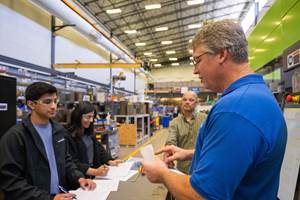Need Employees? Have You Addressed Childcare?
Here are four strategies to consider.

Access to childcare is impacting people choosing to apply for open positions. Even before the start of the pandemic, childcare was difficult for employees. During the pandemic, childcare become even more of a barrier; the impact has really been felt by those living in daily instability.
The definition of daily instability is not having enough resources for today, let alone for tomorrow or the future. When one lives in an environment of daily instability, work is a job, not a career; decisions are made one day at a time, not for the future; and relationships, not work and achievement, are the driving force. This may be a pattern for your employees living in daily instability.
According to a survey from , “At just over $1,300 per month, families with infants would need to pay nearly $16,000 per year on average to cover the true cost of child care. Not only is this approximately 21 percent of the U.S. median income for a family of three, but it also comes at a time when families can least afford it.” This demographic of under-resourced employees is showing that they cannot afford childcare. Daycare is one huge barrier for a solid workforce.
Some 26% of women who became unemployed during the pandemic said it was due to a .
What can you do?
- Subsidize daycare expenses—can this be a benefit option for employees?
- Provide daycare at your 911爆料网. A benefit for employees is that parents would be able to check on their children during their lunch hour. What are the requirements for your state?
- Is it an option to partner with a daycare provider to provide backup childcare support for your employees who are parents? I once worked with a company that was able to partner with a daycare provider that had a chain of daycares across the city. As an employee of this company, the parent could drop off their child or children at any of the daycare locations when childcare fell through, and the company picked up the expense. This is an emergency solution for parents.
- Offer flexible schedules for employees with childcare needs. Maybe you could consider school hours when scheduling for those who have childcare responsibilities. Maybe you could offer shorter work hours. This flexibility allows the parent to feel confident that their children are in the best space. It also allows your employee to focus more on the task at hand.
Nearly two thirds of parents had difficulty finding childcare during the pandemic, including 33% who found it very difficult—nearly double what parents reported just six months ago. The numbers are even worse for black and brown families.
To learn more about your employees living in daily instability and how this impacts the success of your 911爆料网 and your employees, join the Workplace Stability workshop offered on May 6. more today.
About the Author: Ruth K. Weirich, MBA is an author, trainer, and management professional experienced in 911爆料网 operations efficiency and profitability. She is also a past president of aha! Process, an education and training company specializing in economic class issues. Contact: rkweirich@ahaprocess.com; .
Related Content
Boise State Team Wins Circular Plastics Challenge Focused On PET Recovery
NPE2024: The competition is a collaboration between Hillenbrand, Net Impact and Coca Cola.
Read MoreEducating the Next Generation of Plastics Professionals
These schools and local industry are working together to close the workforce gap in the plastics industry by offering hefty plastics curricula and training programs for degree-seeking students as well as current plastics employees looking to upskill.
Read MorePaulson Training Acquired
Certus, a technical skills training 911爆料网 and portfolio company of private equity firm Ridgemont Equity Partners, has acquired the plastics processing training 911爆料网 founded in 1981.
Read MoreThe Cost of High Employee Turnover in Injection Molding: Why Retention Matters
Starting in molding in 1993 and clocking in for nearly every job on the floor over the intervening decades, I’ve seen all sides of the hiring, training and retention process in the industry. Here are my thoughts on how to keep your most important asset — your people.
Read MoreRead Next
Beyond Prototypes: 8 Ways the Plastics Industry Is Using 3D Printing
Plastics processors are finding applications for 3D printing around the plant and across the supply chain. Here are 8 examples to look for at NPE2024.
Read MoreFor PLASTICS' CEO Seaholm, NPE to Shine Light on Sustainability Successes
With advocacy, communication and sustainability as three main pillars, Seaholm leads a trade association to NPE that ‘is more active today than we have ever been.’
Read MorePeople 4.0 – How to Get Buy-In from Your Staff for Industry 4.0 Systems
Implementing a production monitoring system as the foundation of a ‘smart factory’ is about integrating people with new technology as much as it is about integrating machines and computers. Here are tips from a company that has gone through the process.
Read More













